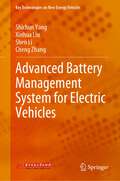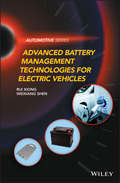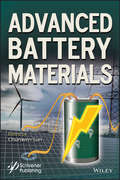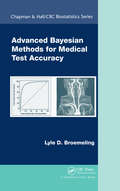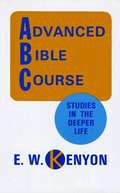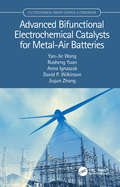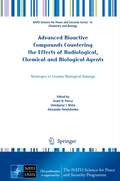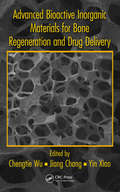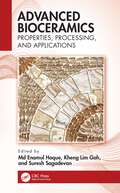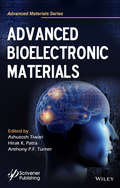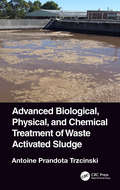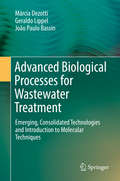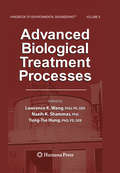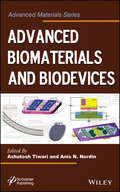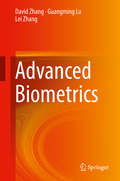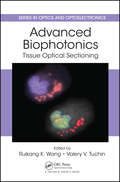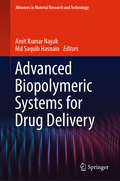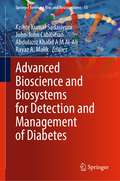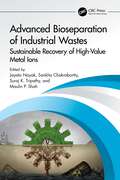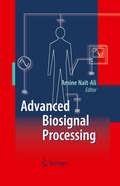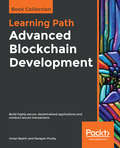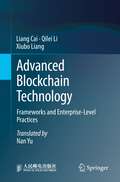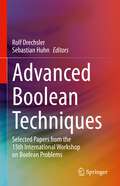- Table View
- List View
Advanced Battery Management System for Electric Vehicles (Key Technologies on New Energy Vehicles)
by Xinhua Liu Cheng Zhang Shichun Yang Shen LiThe battery management system (BMS) optimizes the efficiency of batteries under allowable conditions and prevents serious failure modes. This book focuses on critical BMS techniques, such as battery modeling; estimation methods for state of charge, state of power and state of health; battery charging strategies; active and passive balancing methods; and thermal management strategies during the entire lifecycle. It also introduces functional safety and security-related design for BMS, and discusses potential future technologies, like digital twin technology.
Advanced Battery Management Technologies for Electric Vehicles (Automotive Series)
by Rui Xiong Weixiang ShenA comprehensive examination of advanced battery management technologies and practices in modern electric vehicles Policies surrounding energy sustainability and environmental impact have become of increasing interest to governments, industries, and the general public worldwide. Policies embracing strategies that reduce fossil fuel dependency and greenhouse gas emissions have driven the widespread adoption of electric vehicles (EVs), including hybrid electric vehicles (HEVs), pure electric vehicles (PEVs) and plug-in electric vehicles (PHEVs). Battery management systems (BMSs) are crucial components of such vehicles, protecting a battery system from operating outside its Safe Operating Area (SOA), monitoring its working conditions, calculating and reporting its states, and charging and balancing the battery system. Advanced Battery Management Technologies for Electric Vehicles is a compilation of contemporary model-based state estimation methods and battery charging and balancing techniques, providing readers with practical knowledge of both fundamental concepts and practical applications. This timely and highly-relevant text covers essential areas such as battery modeling and battery state of charge, energy, health and power estimation methods. Clear and accurate background information, relevant case studies, chapter summaries, and reference citations help readers to fully comprehend each topic in a practical context. Offers up-to-date coverage of modern battery management technology and practice Provides case studies of real-world engineering applications Guides readers from electric vehicle fundamentals to advanced battery management topics Includes chapter introductions and summaries, case studies, and color charts, graphs, and illustrations Suitable for advanced undergraduate and graduate coursework, Advanced Battery Management Technologies for Electric Vehicles is equally valuable as a reference for professional researchers and engineers.
Advanced Battery Materials
by Chunwen SunElectrochemical energy storage has played important roles in energy storage technologies for portable electronics and electric vehicle applications. During the past thirty years, great progress has been made in research and development of various batteries, in term of energy density increase and cost reduction. However, the energy density has to be further increased to achieve long endurance time. In this book, recent research and development in advanced electrode materials for electrochemical energy storage devices are presented, including lithium ion batteries, lithium-sulfur batteries and metal-air batteries, sodium ion batteries and supercapacitors. The materials involve transition metal oxides, sulfides, Si-based material as well as graphene and graphene composites.
Advanced Battle Management System: Needs, Progress, Challenges, And Opportunities Facing The Department Of The Air Force
by National Academies of Sciences, Engineering, and Medicine Division on Engineering and Physical Sciences Air Force Studies Board Committee on Air Force Advanced Battle Management SystemThe U.S. Department of Defense is pursuing an improved ability to more closely integrate and operate jointly against agile adversaries through Joint All-Domain Command and Control (JADC2). This framework will seamlessly integrate sensors, networks, platforms, commanders, operators, and weapon systems for rapid information collection, decision-making, and projection of joint and multinational forces. The Department of the Air Force's contribution to JADC2 is the Advanced Battle Management System (ABMS). As an evolving system in the early stages of definition, ABMS architecture and its supporting elements remain dynamic. Advanced Battle Management System assesses the technical approach being employed by ABMS and its ability to effectively support the range of system integration desired, while also supporting operational and development agility; and the governance being applied by ABMS and if it is appropriate and sufficient to enable quick development and evolution of capabilities while maintaining appropriate government control over the output.
Advanced Bayesian Methods for Medical Test Accuracy (Chapman & Hall/CRC Biostatistics Series)
by Lyle D. BroemelingUseful in many areas of medicine and biology, Bayesian methods are particularly attractive tools for the design of clinical trials and diagnostic tests, which are based on established information, usually from related previous studies. Advanced Bayesian Methods for Medical Test Accuracy begins with a review of the usual measures such as specificity
Advanced Bible Course, Studies in the Deeper Life
by E. W. KenyonThis Book is a follow up to the book called The Bible in the Light of Our Redemption, by E. W. Kenyon. It is a deeper study of the Bible and how it influences our life. I found this book very enlightening. Once I started reading it, I could not put it down. As a result of reading this book, I have found a deeper appreciation for the Bible and I have reached a higher spiritual level of existence.
Advanced Bifunctional Electrochemical Catalysts for Metal-Air Batteries (Electrochemical Energy Storage and Conversion)
by Yan-Jie Wang Rusheng Yuan Anna Ignaszak David P. Wilkinson Jiujun ZhangMetal-air batteries (MABs) have attracted attention because of their high specific energy, low cost, and safety features. This book discusses science and technology including material selection, synthesis, characterization, and their applications in MABs. It comprehensively describes various composite bifunctional electrocatalysts, corrosion/oxidation of carbon-containing air cathode catalysts, and how improvements can be achieved in the catalytic activities of oxygen reduction reaction and oxygen evolution reaction and their durability/stability. This book also analyzes, compares, and discusses composite bifunctional electrocatalysts in the applications of MABs, matching the fast information of commercial MABs in requirements. Aimed at researchers and industry professionals, this comprehensive work provides readers with an appreciation for what bifunctional composite electrocatalysts are capable of, how this field has grown in the past decades, and how bifunctional composite electrocatalysts can significantly improve the performance of MABs. It also offers suggestions for future research directions to overcome technical challenges and further facilitate research and development in this important area.
Advanced Bioactive Compounds Countering the Effects of Radiological, Chemical and Biological Agents: Strategies to Counter Biological Damage (NATO Science for Peace and Security Series A: Chemistry and Biology)
by Volodymyr I. Mizin Alexander Omelchenko Grant N. PierceThe probability for exposure to damaging radiation, toxic chemicals in the environment and adverse biological agents has increased exponentially today. The more frequent and faster travel that we experience today also escalates the risk of contraction and transmission of potentially deadly infections. This has created a very real and escalating risk for injuries and deaths. This is accentuated in the military and medical staff that is more frequently exposed to radiological, chemical, and biological agents in their normal working environment. Understanding the mechanisms whereby these toxic agents inflict damage to our bodies is essential to prepare us for these challenges. Much of the damage is inflicted through the generation of free radicals and non-radical oxidants which then act through oxidative mechanisms to injury the body. This volume will discuss the damage caused by these radiological, chemical, and biological environmental stressors, the mechanisms through which the damage can occur and the novel strategies that can be used to reduce the injury inflicted by these toxic compounds. Using basic and clinical research approaches, the contents of this book discuss new ideas for the development of bioactive products and environmental approaches to lessen or negate the biological damage inflicted by these noxious compounds.
Advanced Bioactive Inorganic Materials for Bone Regeneration and Drug Delivery
by Chengtie Wu Jiang Chang Yin XiaoBioceramics play an important role in repairing and regenerating defective or damaged bone. This volume reviews the latest advances in the field. Offering guidance for biomedical engineering researchers and material scientists, the book summarizes innovative concepts, bioceramic design, and methods for material synthesis and drug delivery. It covers design and fabrication of these materials, down to the nanoscale, and includes chapters on medical device engineering using these materials. The book is designed to enhance study and career development for those in this field and to facilitate further research and opportunities for new solutions.
Advanced Bioceramics: Properties, Processing, and Applications
by Md Enamul Hoque Kheng Lim Goh Suresh SagadevanAdvanced Bioceramics: Properties, Processing, and Applications describes development of bioceramics and biocomposites, which are used in various biomedical applications including bone tissue repair, remodelling and regeneration. It covers the fundamental aspects of materials science and bioengineering, clinical performance in a variety of applications, ISO/ASTM specifications, and opportunities and challenges. • Offers a comprehensive view of properties and processing of bioceramics. • Highlights applications in dentistry, orthopaedic and maxillofacial implants, and regenerative and tissue engineering. • Covers ISO/ASTM specifications such as processing, clinical applications, recycling/reuse and disposal standards. • Explores health, environmental and ethical issues. With contributions from eminent editors and recognized authors around the world, this book should serve as an important reference for academics, scientists, researchers, students and practitioners in materials science and biomedical engineering. It is to assist in the design of novel, targeted and personalised bioceramic-based solutions to advanced healthcare.
Advanced Bioelectronics Materials
by Hirak K. Patra Anthony P. Turner Ashutosh TiwariThis book covers the recent advances in the development of bioelectronics systems and their potential application in future biomedical applications starting from system design to signal processing for physiological monitoring, to in situ biosensing. Advanced Bioelectronics Materialshas contributions from distinguished international scholars whose backgrounds mirror the multidisciplinary readership ranging from the biomedical sciences, biosensors and engineering communities with diverse backgrounds, interests and proficiency in academia and industry. The readers will benefit from the widespread coverage of the current literature, state-of-the-art overview of all facets of advanced bioelectronics materials ranging from real time monitoring, in situ diagnostics, in vivo imaging, image-guided therapeutics, biosensors, and translational biomedical devices and personalized monitoring.
Advanced Biofuels and Bioproducts
by James W. LeeDesigned as a text not only for students and researchers, but anyone interested in green technology, Advanced Biofuels and Bioproducts offers the reader a vast overview of the state-of-the-art in renewable energies. The typical chapter sets out to explain the fundamentals of a new technology as well as providing its context in the greater field. With contributions from nearly 100 leading researchers across the globe, the text serves as an important and timely look into this rapidly expanding field. The 40 chapters that comprise Advanced Biofuels and Bioproducts are handily organized into the following 8 sections: · Introduction and Brazil's biofuel success · Smokeless biomass pyrolysis for advanced biofuels production and global biochar carbon sequestration · Cellulosic Biofuels · Photobiological production of advanced biofuels with synthetic biology · Lipids-based biodiesels · Life-cycle energy and economics analysis · High-value algal products and biomethane · Electrofuels
Advanced Biological, Physical, and Chemical Treatment of Waste Activated Sludge
by Antoine Prandota TrzcinskiRecently, research efforts aiming to improve energy efficiency of wastewater treatment processes for large centralized wastewater treatment plants (WWTPs) have been increasing. Global warming impacts, energy sustainability, and biosolids generation are among several key drivers towards the establishment of energy-efficient WWTPs. WWTPs have been recognized as major contributors of greenhouse gas emissions as these are significant energy consumers in the industrialized world. The quantity of biosolids or excess waste activated sludge produced by WWTP will increase in the future due to population growth and this pose environmental concerns and solid waste disposal issues. Due to limited capacity of landfill sites, more stringent environmental legislation, and air pollution from incineration sites, there is a need to rethink the conventional way of dealing with wastewater and the sludge production that comes with it. This book provides an overview of advanced biological, physical and chemical treatment with the aim of reducing the volume of sewage sludge. Provides a comprehensive list of processes aiming at reducing the volume of sewage sludge and increasing biogas production from waste activated sludge. Includes clear process flowsheet showing how the process is modified compared to the conventional waste activated sludge process. Provides current technologies applied on full scale plant as well as methods still under investigation at laboratory scale. Offers data from pilot scale experience of these processes
Advanced Biological Processes for Wastewater Treatment: Emerging, Consolidated Technologies and Introduction to Molecular Techniques
by Márcia Dezotti Geraldo Lippel João Paulo BassinThis book presents recent developments in advanced biological treatment technologies that are attracting increasing attention or that have a high potential for large-scale application in the near future. It also explores the fundamental principles as well as the applicability of the engineered bioreactors in detail. It describes two of the emerging technologies: membrane bioreactors (MBR) and moving bed biofilm reactors (MBBR), both of which are finding increasing application worldwide thanks to their compactness and high efficiency. It also includes a chapter dedicated to aerobic granular sludge (AGS) technology, and discusses the main features and applications of this promising process, which can simultaneously remove organic matter, nitrogen and phosphorus and is considered a breakthrough in biological wastewater treatment. Given the importance of removing nitrogen compounds from wastewater, the latest advances in this area, including new processes for nitrogen removal (e. g. Anammox), are also reviewed. Developments in molecular biology techniques over the last twenty years provide insights into the complex microbial diversity found in biological treatment systems. The final chapter discusses these techniques in detail and presents the state-of-the-art in this field and the opportunities these techniques offer to improve process performance.
Advanced Biological Treatment Processes: Volume 9 (Handbook of Environmental Engineering #9)
by Lawrence K. Wang Yung-Tse Hung Nazih K. ShammasVolume 9: Advanced Biological Treatment Processes in the Handbook of Environmental Engineering series provides critical insight into pollution-abatement engineering. This outstanding collection of methodologies is designed as a review of engineering systems currently being used, as well as their potential for use in pollution abatement. The book's expert panel of authors provides a look at a range of topics, including principles and kinetics of biological processes, vertical shaft bioreactors, upflow sludge blanket filtration, membrane bioreactors, column bioreactor, SBR, nitrification, denitrification, and emerging biological processes. Volume 9: Advanced Biological Treatment Processes and its sister book - Volume 8: Biological Treatment Processes - are indispensable as both basic biological treatment textbooks and comprehensive reference books for advanced undergraduate and graduate students, designers of waste treatment systems, scientists, and researchers. A gold-standard addition to The Humana Press series, Volume 9: Advanced Biological Treatment Processes gives readers a cutting-edge illustration of the theory and practice of biological abatement systems and their critical role in environmental issues today.
Advanced Biomaterials and Biodevices (Advanced Material Series)
by Ashutosh Tiwari Anis N. NordinBiomaterials are the fastest-growing emerging field of biodevices. Design and development of biomaterials play a significant role in the diagnosis, treatment, and prevention of diseases. Recently, a variety of scaffolds/carriers have been evaluated for tissue regeneration, drug delivery, sensing and imaging. Liposomes and microspheres have been developed for sustained delivery. Several anti-cancer drugs have been successfully formulated using biomaterial. The targeting of drugs to certain physiological sites has emerged as a promising tool in the treatment with improved drug bioavailability and reduction of dosing frequency. Biodevices-based targeting of drugs may improve the therapeutic success by limiting the adverse drug effects and resulting in more patient compliance and attaining a higher adherence level. Advanced biodevices hold merit as a drug carrier with high carrier capacity, feasibility of incorporation of both hydrophilic and hydrophobic substances, high stability, as well as the feasibility of variable courses. Biodevices for diagnosis of diseases by improving the sensitivity and selectivity on the biomaterials platform is the most latest R & D focus especially in the field of treatment by the prognosis and detection of disease in the early stage. This groundbreaking book is devoted to all of the emerging areas of biomaterials and biodevices including therapeutic agents, molecular targeting and diagnostic imaging capabilities. The senior contributors write on the following topics:Frontiers for bulk nanostructured metalsStimuli-responsive materials used as medical devicesRecent advances with liposomes as drug carriersFabrication, Properties of nanoshells with controllable surface chargeAdvanced healthcare materials: ChitosanAnticipating behaviour of advanced material in healthcareLabel free biochipsPolymer MEMS sensorsAssembly of polymers/metal nanoparticlesCombination of molecular imprinting and nanotechnologyEfficiency of biosensors as new generation of analytical approachesState-of-the-art of biosensors in healthcare
Advanced Biometrics: International Conference, Icb 2006, Hong Kong, China, January 5-7, 2006, Proceedings (Lecture Notes in Computer Science #3832)
by Lei Zhang David Zhang Guangming LuThis book describes a range of new biometric technologies, such as high-resolution fingerprint, finger-knuckle-print, multi-spectral backhand, 3D fingerprint, tongueprint, 3D ear, and multi-spectral iris technologies. Further, it introduces readers to efficient feature extraction, matching and fusion algorithms, in addition to developing potential systems of its own. These advanced biometric technologies and methods are divided as follows: 1. High-Resolution Fingerprint Recognition; 2. Finger-Knuckle-Print Verification; 3. Other Hand-Based Biometrics; and 4. New Head-Based Biometrics. Traditional biometric technologies, such as fingerprint, face, iris, and palmprint, have been extensively studied and addressed in many research books. However, all of these technologies have their own advantages and disadvantages, and there is no single type of biometric technology that can be used for all applications. Many new biometric technologies have been developed in recent years, especially in response to new applications. The contributions gathered here focus on how to develop a new biometric technology based on the requirements of essential applications, and how to design efficient algorithms that yield better performance.
Advanced Biophotonics: Tissue Optical Sectioning (Series in Optics and Optoelectronics)
by Ruikang K. Wang Valery V. TuchinDespite a number of books on biophotonics imaging for medical diagnostics and therapy, the field still lacks a comprehensive imaging book that describes state-of-the-art biophotonics imaging approaches intensively developed in recent years. Addressing this shortfall, Advanced Biophotonics: Tissue Optical Sectioning presents contemporary methods and
Advanced Biopolymeric Systems for Drug Delivery (Advances in Material Research and Technology #133)
by Amit Kumar Nayak Md Saquib HasnainThis book discusses the recent innovations in the development of various advanced biopolymeric systems, including gels, in situ gels, hydrogels, interpenetrating polymer networks (IPNs), polyelectrolyte complexes (PECs), graft co-polymers, stimuli-responsive polymers, polymeric nanoparticles, nanocomposites, polymeric micelles, dendrimers, liposomes and scaffolds. It also examines their applications in drug delivery.
Advanced Bioscience and Biosystems for Detection and Management of Diabetes (Springer Series on Bio- and Neurosystems #13)
by Kishor Kumar Sadasivuni John-John Cabibihan Abdulaziz Khalid A M Al-Ali Rayaz A. MalikThis book covers the medical condition of diabetic patients, their early symptoms and methods conventionally used for diagnosing and monitoring diabetes. It describes various techniques and technologies used for diabetes detection. The content is built upon moving from regressive technology (invasive) and adapting new-age pain-free technologies (non-invasive), machine learning and artificial intelligence for diabetes monitoring and management. This book details all the popular technologies used in the health care and medical fields for diabetic patients. An entire chapter is dedicated to how the future of this field will be shaping up and the challenges remaining to be conquered. Finally, it shows artificial intelligence and predictions, which can be beneficial for the early detection, dose monitoring and surveillance for patients suffering from diabetes
Advanced Bioseparation of Industrial Wastes: Sustainable Recovery of High-Value Metal Ions
by Jayato Nayak Sankha Chakrabortty Suraj K. Tripathy Maulin P. ShahAdvanced Bioseparation of Industrial Wastes: Sustainable Recovery of High-Value Metal Ions examines resource recovery from a variety of industrial waste streams, including sludge and wastewater, with an emphasis on both the fundamentals and the more advanced concepts involved. Chemical leaching, waste treatment, and other processes for metal extraction are broken down into their component parts in great detail. Several important metals, such as lithium, copper, gold, platinum, nickel, zinc, chromium, uranium, cobalt, rhodium, and indium, could be salvaged from recyclables. This book presents the best practices for dealing with waste from industries such as those involved in the production of electronic goods, automobiles, batteries, as well as mining and electroplating. It provides readers with a comprehensive understanding of the many forms of industrial waste, including their composition, recycling processes, and the potential for recovery of essential metals, from the ground up.Features: Provides updated occurrence and characteristics of a variety of high-value metal ions that can be recovered from different industrial wastes. Presents advanced chemical leaching technologies for those metal ions. Describes detailed accounts of physico-chemical-based reuse and recycle methodologies. Covers innovative approaches for the reutilization and management of industrial wastes.
Advanced Biosignal Processing
by Amine Nait-AliThrough 17 chapters, this book presents the principle of many advanced biosignal processing techniques. After an important chapter introducing the main biosignal properties as well as the most recent acquisition techniques, it highlights five specific parts which build the body of this book. Each part concerns one of the most intensively used biosignals in the clinical routine, namely the Electrocardiogram (ECG), the Elektroenzephalogram (EEG), the Electromyogram (EMG) and the Evoked Potential (EP). In addition, each part gathers a certain number of chapters related to analysis, detection, classification, source separation and feature extraction. These aspects are explored by means of various advanced signal processing approaches, namely wavelets, Empirical Modal Decomposition, Neural networks, Markov models, Metaheuristics as well as hybrid approaches including wavelet networks, and neuro-fuzzy networks. The last part, concerns the Multimodal Biosignal processing, in which we present two different chapters related to the biomedical compression and the data fusion. Instead organising the chapters by approaches, the present book has been voluntarily structured according to signal categories (ECG, EEG, EMG, EP). This helps the reader, interested in a specific field, to assimilate easily the techniques dedicated to a given class of biosignals. Furthermore, most of signals used for illustration purpose in this book can be downloaded from the Medical Database for the Evaluation of Image and Signal Processing Algorithm. These materials assist considerably the user in evaluating the performances of their developed algorithms. This book is suited for final year graduate students, engineers and researchers in biomedical engineering and practicing engineers in biomedical science and medical physics.
Advanced Blockchain Development: Build highly secure, decentralized applications and conduct secure transactions
by Imran Bashir Narayan PrustyExplore distributed ledger technology, decentralization, and smart contracts and develop real-time decentralized applications with Ethereum and SolidityKey FeaturesGet to grips with the underlying technical principles and implementations of blockchainBuild powerful applications using Ethereum to secure transactions and create smart contractsGain advanced insights into cryptography and cryptocurrenciesBook DescriptionBlockchain technology is a distributed ledger with applications in industries such as finance, government, and media. This Learning Path is your guide to building blockchain networks using Ethereum, JavaScript, and Solidity. You will get started by understanding the technical foundations of blockchain technology, including distributed systems, cryptography and how this digital ledger keeps data secure. Further into the chapters, you’ll gain insights into developing applications using Ethereum and Hyperledger. As you build on your knowledge of Ether security, mining , smart contracts, and Solidity, you’ll learn how to create robust and secure applications that run exactly as programmed without being affected by fraud, censorship, or third-party interference. Toward the concluding chapters, you’ll explore how blockchain solutions can be implemented in applications such as IoT apps, in addition to its use in currencies. The Learning Path will also highlight how you can increase blockchain scalability and even discusses the future scope of this fascinating and powerful technology. By the end of this Learning Path, you'll be equipped with the skills you need to tackle pain points encountered in the blockchain life cycle and confidently design and deploy decentralized applications.This Learning Path includes content from the following Packt products:Mastering Blockchain - Second Edition by Imran BashirBuilding Blockchain Projects by Narayan PrustyWhat you will learnUnderstand why decentralized applications are importantDiscover the mechanisms behind bitcoin and alternative cryptocurrenciesMaster how cryptography is used to secure data with the help of examplesMaintain, monitor, and manage your blockchain solutionsCreate Ethereum walletsExplore research topics and the future scope of blockchain technologyWho this book is forThis Learning Path is designed for blockchain developers who want to build decentralized applications and smart contracts from scratch using Hyperledger. Basic familiarity with any programming language will be useful to get started with this Learning Path.
Advanced Blockchain Technology: Frameworks and Enterprise-Level Practices
by Liang Cai Qilei Li Xiubo LiangThis book is a must-have for blockchain developers who want to learn from scratch how to leverage blockchain technology in a real-world setting. The first section provides a brief overview of blockchain technology, including its concepts, history, technology genre, major related companies and typical application scenarios, and presents an ecological map for the blockchain industry by comparing and analyzing some mainstream platforms.The second section systematically introduces Ethereum and HyperLedger, exemplars of well-known open-source blockchain platforms, and demonstrates how to conduct blockchain applications development based on the two platforms.The third section illustrates core technology of enterprise blockchain platforms (to take Hyperchain, an independent, controllable blockchain alliance as an example), and covers Hyperchain based enterprise blockchain applications development technology.The fourth section presents 6 actual blockchain-based applications examples, and analyzes applications development procedure and related key codes. Examples in this book are of great practicability and operability, allowing practitioners to get started easily, and eventually utilize these skills to develop real-life, usable blockchain applications.
Advanced Boolean Techniques: Selected Papers from the 15th International Workshop on Boolean Problems
by Rolf Drechsler Sebastian HuhnThis book describes recent findings in the domain of Boolean logic and Boolean algebra, covering application domains in circuit and system design, but also basic research in mathematics and theoretical computer science. Content includes invited chapters and a selection of the best papers presented at the 15th annual International Workshop on Boolean Problems.
